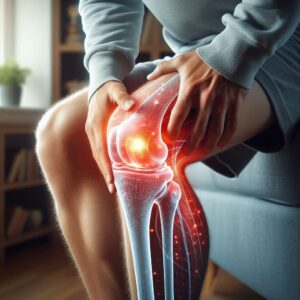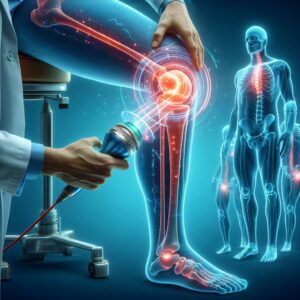Proven Strategies to Prevent Knee Bursitis and Enhance Joint Longevity
Knee bursitis is a complex ailment marked by the inflammation of small fluid-filled sacs called bursae, which are crucial for protecting the knee joint. These bursae act as cushions, providing a barrier between the bones and the surrounding soft tissues, thereby facilitating smooth and pain-free movement. Engaging in activities that place excessive pressure on the knee, such as running, kneeling, or even sitting for extended periods, can lead to irritation, resulting in inflammation of the bursae. This inflammation can produce significant pain and discomfort, interfering with daily tasks and diminishing one's overall quality of life. The knee's intricate anatomy, particularly key bursae like the prepatellar bursa in front of the kneecap and the infrapatellar bursa just below it, make it especially susceptible to bursitis. Understanding the anatomy and function of these bursae is essential for recognizing their role in joint health and the potential complications caused by inflammation.
Vital Insights into Knee Bursitis: Understanding the Condition
- Knee bursitis, often referred to as housemaid's knee or clergyman's knee, involves the inflammation of bursae—small, fluid-filled sacs that cushion the knee joint and protect it during movement.
- Common signs of knee bursitis include localized pain, noticeable swelling, and tenderness around the knee. A comprehensive physical examination, often coupled with imaging tests, is critical for an accurate diagnosis.
- Typical treatment methods for bursitis focus on rest, ice application, compression techniques, elevation, and over-the-counter pain relief medications to help manage discomfort.
- Non-surgical treatment options may include corticosteroid injections, physical therapy, and ultrasound therapy, all aimed at promoting recovery and restoring knee functionality.
- Implementing thoughtful lifestyle adjustments—such as maintaining a healthy weight, selecting supportive footwear, and avoiding aggravating activities—can significantly improve the management of knee bursitis.
 Recognizing Symptoms of Knee Bursitis for Timely Intervention
Recognizing Symptoms of Knee Bursitis for Timely Intervention
Identifying the Key Symptoms of Knee Bursitis
If you're concerned that you might be suffering from knee bursitis, pay attention to localized swelling around the knee joint, often accompanied by tenderness and warmth in that area. The pain typically intensifies with movement or pressure, making activities like climbing stairs or kneeling especially uncomfortable. Many individuals experience a pulsating pain that interferes with their ability to carry out daily tasks efficiently. Recognizing these symptoms is crucial for timely intervention and effective management of this condition. If you suspect you have knee bursitis, it is vital to seek medical guidance promptly to prevent further complications and facilitate timely treatment.
Understanding the Impact of Knee Bursitis on Daily Life
The presence of knee bursitis can drastically limit your range of motion, making everyday activities much more challenging. Tasks such as walking, sitting, or standing may become increasingly difficult, which can adversely affect your overall quality of life. The discomfort associated with bursitis may force you to reduce your activity levels, potentially leading to a more sedentary lifestyle with long-term health implications. Understanding how knee bursitis affects your daily routine is essential for motivating you to seek appropriate treatment and implement necessary lifestyle adjustments to improve your condition.
Thorough Evaluation and Treatment Options for Knee Bursitis
When diagnosing knee bursitis, a healthcare professional typically begins with a comprehensive physical examination. They will inquire about your medical history and any recent activities that may have led to your symptoms. Additionally, imaging tests like X-rays or MRI scans may be employed to rule out other injuries or conditions, such as fractures or ligament tears. By gaining a thorough understanding of your symptoms and undergoing a detailed diagnostic process, you can take proactive steps toward effective treatment and recovery, ultimately ensuring a more favorable outcome.
Effective Treatment Strategies for Relieving Knee Bursitis Symptoms
The primary objective of conventional treatment methods for bursitis is to reduce inflammation and alleviate pain. An essential approach to achieving this involves ensuring sufficient rest; allowing your knee to recover from activities that exacerbate the condition is crucial for creating a healing environment. Moreover, ice therapy can be immensely beneficial. Applying ice packs to the affected area for 15-20 minutes several times daily can significantly diminish swelling and numb pain. This straightforward yet powerful technique can be transformative in managing bursitis symptoms effectively.
Over-the-counter medications, specifically nonsteroidal anti-inflammatory drugs (NSAIDs), are often recommended to manage pain and inflammation efficiently. In more severe cases, healthcare providers may choose to administer corticosteroid injections directly into the bursa, providing rapid relief from symptoms. While traditional treatments can effectively manage the symptoms, it is equally important to address the underlying causes of bursitis. Therefore, investigating complementary therapies may also prove beneficial on your recovery journey.
 Exploring Innovative Non-Surgical Treatments for Comprehensive Knee Bursitis Management
Exploring Innovative Non-Surgical Treatments for Comprehensive Knee Bursitis Management
In recent times, various non-surgical therapies have emerged as effective alternatives for managing knee bursitis. Among these, <a href="https://mcrtherapies.co.uk/extracorporeal-shockwave-therapy-unveiling-its-potential/">shockwave therapy</a> has gained recognition as a promising treatment option. This innovative procedure employs high-energy sound waves that are directed at the affected area, promoting healing through enhanced blood flow and stimulation of cellular repair processes. Many patients have reported that shockwave therapy effectively alleviates pain and improves mobility, allowing them to return to their daily routines with greater ease.
Another non-invasive alternative worth considering is ultrasound therapy, which utilizes sound waves to penetrate deep into tissues. This effective treatment can significantly reduce inflammation and facilitate healing by improving blood circulation in the affected area. Both shockwave and ultrasound therapies are generally well-tolerated and can be conveniently conducted in outpatient settings, making them appealing options for individuals seeking relief from knee bursitis without resorting to surgical procedures.
Making Lifestyle Changes to Enhance Knee Health
Implementing specific lifestyle adjustments can have a profound effect on your ability to effectively manage prepatellar or infrapatellar bursitis. A significant modification involves integrating low-impact exercises into your fitness routine. Activities such as swimming or cycling can help maintain cardiovascular fitness while exerting minimal stress on your knees. Additionally, managing your weight is essential; carrying excess weight can increase stress on your joints, potentially exacerbating bursitis symptoms.
Furthermore, being mindful of your posture and body mechanics during daily tasks is crucial. Utilizing correct techniques when lifting heavy objects or engaging in sports can significantly reduce unnecessary stress on the knee. Incorporating stretching and strengthening exercises into your regimen can enhance flexibility and strengthen the muscles surrounding your knee joint. By adopting these lifestyle changes, you can create a more supportive environment for your knees, thereby decreasing the risk of future flare-ups and improving your overall well-being.
The Essential Role of Physical Therapy in Rehabilitating Knee Bursitis
Physical therapy is a critical component of the rehabilitation process for those dealing with knee bursitis. A licensed physical therapist collaborates with you to create a tailored treatment plan that meets your specific needs and rehabilitation goals. This comprehensive plan may include exercises designed to strengthen the muscles around your knee, enhance flexibility, and improve overall functional abilities.
Participating in targeted exercises through physical therapy can effectively reduce pain and restore mobility to your knee joint. In addition to strengthening workouts, your physical therapist might integrate modalities such as ultrasound or electrical stimulation during treatment sessions, which can further aid in diminishing inflammation and expediting the healing process. Regular appointments with a physical therapist provide valuable guidance and support, playing a significant role in a successful recovery journey.
 Investigating Alternative Therapies for Improved Knee Bursitis Management
Investigating Alternative Therapies for Improved Knee Bursitis Management
Beyond conventional treatments, many individuals turn to alternative therapies to effectively complement their bursitis management strategies. Acupuncture has gained popularity as a legitimate option, noted for its ability to relieve pain and promote healing through the targeted stimulation of specific body points. Numerous patients report experiencing decreased inflammation and enhanced overall wellness following acupuncture treatments.
Another alternative therapy to consider is massage therapy, which can help relieve muscle tension surrounding the knee joint, promote relaxation, and improve circulation. By addressing tension in adjacent muscles, massage therapy can effectively alleviate pain linked to bursitis. Exploring these alternative therapies can provide additional avenues for managing your knee condition while simultaneously enhancing your overall quality of life.
Proactive Strategies to Prevent Recurring Knee Bursitis
Taking a proactive stance that integrates various strategies is vital for preventing the recurrence of knee bursitis. First and foremost, it is crucial to listen to your body and recognize when it’s appropriate to take a break. If you notice signs of discomfort or swelling after physical activity, allow your knees the necessary time to recuperate. Gradually increasing the intensity of your workouts can also help prevent overuse injuries, ensuring that your body can adapt appropriately.
Moreover, incorporating strength training exercises into your routine can significantly bolster knee health by building muscle around the joint. Strong muscles provide stability and reduce the likelihood of injury during physical activities. Investing in supportive footwear that offers adequate cushioning and arch support during exercise or daily activities is also beneficial. By implementing these preventive measures, you can greatly decrease the chances of experiencing knee bursitis again.
To deepen your understanding of prepatellar or infrapatellar bursitis and effectively explore various treatment options, seeking reliable resources is crucial. Researching therapies that alleviate pain and improve mobility is essential for optimal management. Although I don't have a direct article to reference, you can find relevant information, consultations, and therapeutic products by visiting MCR Therapies. This platform offers a diverse range of therapeutic solutions tailored to assist in managing the symptoms of knee bursitis.
Frequently Asked Questions Regarding Knee Bursitis and Its Management
What is knee bursitis and how does it impact the knee joint?
Knee bursitis, particularly prepatellar or infrapatellar bursitis, is an inflammatory condition affecting the bursae, the small fluid-filled sacs that cushion the knee joint. When these bursae become inflamed, it can lead to pain, swelling, and restricted movement within the knee, significantly disrupting daily activities.
What common factors contribute to the onset of knee bursitis?
Several factors can trigger knee bursitis, including overuse, trauma, infections, or underlying conditions like arthritis. Activities that involve repetitive pressure on the knee, such as kneeling or running, are frequently implicated in the development of this condition.
What symptoms should I be aware of if I suspect knee bursitis?
Symptoms of prepatellar or infrapatellar bursitis typically manifest as pain, swelling, warmth, and tenderness surrounding the knee joint. Additionally, individuals may experience restricted movement and discomfort when bending or straightening the knee.
How do healthcare professionals accurately diagnose knee bursitis?
A healthcare professional typically diagnoses knee bursitis through a combination of physical examination, a review of your medical history, and potentially imaging tests such as X-rays or MRI scans to rule out other possible causes of knee pain.
What treatment options are available for effectively managing knee bursitis?
Treatment options for knee bursitis may include rest, ice therapy, compression techniques, elevation (commonly known as RICE), the use of nonsteroidal anti-inflammatory drugs (NSAIDs), physical therapy, and, in some cases, aspiration of bursa fluid or corticosteroid injections. In more severe scenarios, surgical intervention may be necessary to alleviate persistent symptoms.
What is the expected recovery timeline for knee bursitis?
The recovery duration for knee bursitis varies based on the severity of the condition and an individual's response to treatment. With appropriate rest and care, many people can anticipate recovering from knee bursitis within a few weeks to several months, depending on their specific circumstances.
Presented By: Knee Bursitis Therapy
The Article: Knee Bursitis Therapy: Your Essential Guide to Relief appeared first on https://mcrtherapies.co.uk
The Article Knee Bursitis Therapy: Essential Relief Strategies Explained appeared first on https://mcrtherapies.com
The Article Knee Bursitis Therapy: Key Strategies for Effective Relief Was Found On https://limitsofstrategy.com


The insights provided on knee bursitis and the importance of the bursae in joint function are critical for anyone who engages in activities that place stress on their knees. As someone who has been involved in various sports throughout my life, I’ve come to appreciate how susceptible our bodies are to repetitive strain injuries, including bursitis. The complexities of the knee joint, particularly with its various bursae, highlight the need for preventive measures, especially as we age or if we lead a sedentary lifestyle punctuated by sudden bursts of physical activity.
You’ve touched on a key point about how the body’s susceptibility to injuries, especially repetitive strain injuries like bursitis, requires a mindful approach to physical activity. Many people often overlook the role of bursae until discomfort arises. It’s a reminder that our bodies do have their limits, regardless of how active we may consider ourselves.
“I’m glad you found the insights helpful! If you’re interested in learning more about effective strategies to prevent knee injuries and maintain joint health, check out this resource.”
https://forgottenportal.com/ninja
It’s fascinating how much we take our knee joints for granted until something like bursitis interrupts our daily activities! I used to think that only athletes or manual laborers faced this issue, but I’ve seen friends who lead relatively sedentary lifestyles also struggle with knee pain after long hours at a desk. I’ve found incorporating simple stretching routines has not only alleviated discomfort but has also kept my joints feeling more flexible and resilient.
It’s interesting to hear your perspective on knee joints and how they can become a point of concern for anyone, regardless of their lifestyle. I’ve definitely noticed that our bodies can surprise us when we least expect it. It’s easy to overlook the importance of good joint health, especially when we’re caught up in daily routines that may not prioritize movement.
I can totally relate to the surprise of joint issues cropping up in unexpected places; I recently read about how high intensity laser therapy might help tackle back pain, which seems like a great option for those of us who spend long hours sitting.
‘High Intensity Laser Therapy for Back Pain Relief’
https://forgottenportal.com/high-intensity-laser-therapy-for-back-pain-relief/.
Your exploration of knee bursitis and its impact on joint health is both timely and important. I’ve personally encountered my fair share of joint discomfort, particularly in the knees, due to my active lifestyle. It’s fascinating how something as seemingly trivial as the bursae can play such a critical role in our mobility and overall comfort.
It’s really interesting to hear how your active lifestyle has brought you face-to-face with knee discomfort. The bursae, despite their small size, are such unsung heroes in our joints, working hard to cushion and protect. It’s almost surprising how something that seems minor can end up being a major player in our daily comfort.
I appreciate the depth of your exploration into knee bursitis and the importance of understanding the bursae’s role in joint health. As someone who has experienced intermittent knee pain, I can relate to the challenges this condition can pose to daily life. What strikes me most is how often we overlook the small structures that play significant protective roles in our bodies.
This topic really hits home for me because I’ve battled knee issues for a while now, and understanding bursitis feels like a game-changer. It’s fascinating how something as seemingly simple as those little bursae can impact our movement and overall quality of life so much. I used to think knee pain was just something I had to live with until I found out about preventive strategies like modifying exercises and incorporating proper warm-ups.
It’s great to hear that you’ve found some clarity around your knee issues. The bursae might seem minor, but their role in our movement is pretty significant. It’s interesting how recognizing a problem can be the first step toward taking control of your wellness.
“I’m glad to hear that this topic resonates with you! If you’re looking for more tips on managing knee issues and preventing pain, check out this resource that dives deeper into effective strategies.”
https://forgottenportal.com/ninja